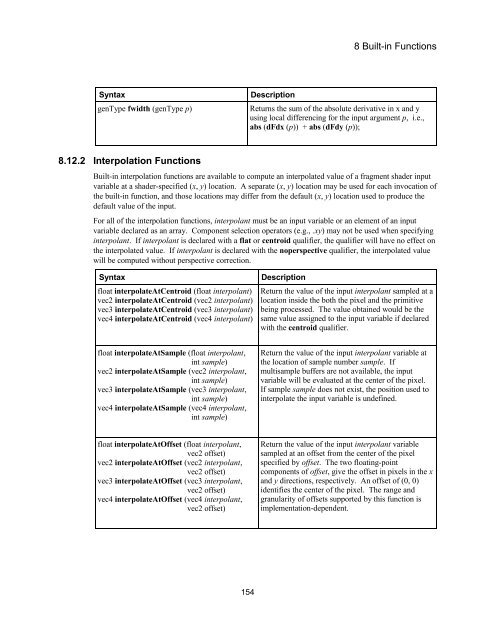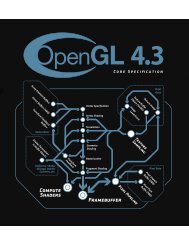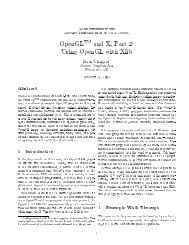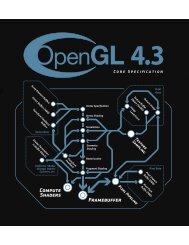Create successful ePaper yourself
Turn your PDF publications into a flip-book with our unique Google optimized e-Paper software.
8 Built-in Functions<br />
Syntax<br />
genType fwidth (genType p)<br />
Description<br />
Returns the sum of the absolute derivative in x and y<br />
using local differencing for the input argument p, i.e.,<br />
abs (dFdx (p)) + abs (dFdy (p));<br />
8.12.2 Interpolation Functions<br />
Built-in interpolation functions are available to compute an interpolated value of a fragment shader input<br />
variable at a shader-specified (x, y) location. A separate (x, y) location may be used for each invocation of<br />
the built-in function, and those locations may differ from the default (x, y) location used to produce the<br />
default value of the input.<br />
For all of the interpolation functions, interpolant must be an input variable or an element of an input<br />
variable declared as an array. Component selection operators (e.g., .xy) may not be used when specifying<br />
interpolant. If interpolant is declared with a flat or centroid qualifier, the qualifier will have no effect on<br />
the interpolated value. If interpolant is declared with the noperspective qualifier, the interpolated value<br />
will be computed without perspective correction.<br />
Syntax<br />
float interpolateAtCentroid (float interpolant)<br />
vec2 interpolateAtCentroid (vec2 interpolant)<br />
vec3 interpolateAtCentroid (vec3 interpolant)<br />
vec4 interpolateAtCentroid (vec4 interpolant)<br />
Description<br />
Return the value of the input interpolant sampled at a<br />
location inside the both the pixel and the primitive<br />
being processed. The value obtained would be the<br />
same value assigned to the input variable if declared<br />
with the centroid qualifier.<br />
float interpolateAtSample (float interpolant,<br />
int sample)<br />
vec2 interpolateAtSample (vec2 interpolant,<br />
int sample)<br />
vec3 interpolateAtSample (vec3 interpolant,<br />
int sample)<br />
vec4 interpolateAtSample (vec4 interpolant,<br />
int sample)<br />
Return the value of the input interpolant variable at<br />
the location of sample number sample. If<br />
multisample buffers are not available, the input<br />
variable will be evaluated at the center of the pixel.<br />
If sample sample does not exist, the position used to<br />
interpolate the input variable is undefined.<br />
float interpolateAtOffset (float interpolant,<br />
vec2 offset)<br />
vec2 interpolateAtOffset (vec2 interpolant,<br />
vec2 offset)<br />
vec3 interpolateAtOffset (vec3 interpolant,<br />
vec2 offset)<br />
vec4 interpolateAtOffset (vec4 interpolant,<br />
vec2 offset)<br />
Return the value of the input interpolant variable<br />
sampled at an offset from the center of the pixel<br />
specified by offset. The two floating-point<br />
components of offset, give the offset in pixels in the x<br />
and y directions, respectively. An offset of (0, 0)<br />
identifies the center of the pixel. The range and<br />
granularity of offsets supported by this function is<br />
implementation-dependent.<br />
154
















